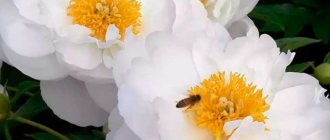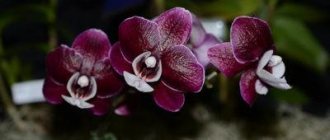Description and photo of white peonies
Today there are a large number of varieties of white peonies known. Based on the color of the bud they are divided into several categories:
- with snow-white flowers;
- with cream buds;
- with red splashes;
- with a yellow core;
- with a greenish tint;
- with pink color in the center.
There is also a classification according to the shape of the buds:
- Terry, with a large number of petals surrounding the middle in 2 - 3 levels. The stamens look similar to petals, but there are varieties with traditional stamens.
- Non-double, consisting of 6-10 petals arranged in two rows. In the center are the pistil and stamens.
- Semi-double have at least five petals. There are non-standard and traditional stamens in the center.
- Japanese or transitional. They are distinguished by their stamens, which are predominantly yellow in color. This species is considered a middle ground between the double and non-double types. The classification is given based on the place of selection of such varieties.
- Anemones have long petals at the bottom and short ones at the top. Outwardly they resemble a ball. Stamens in the form of petals.
This is the main classification of white peonies. The height of these plants does not exceed 100 cm. Most known varieties of peonies are perennial, but there are those that live only one year. The stem is quite strong, so the flower survives strong winds well. The root system grows quickly.
Features of planting and care
Beautiful white peonies do not have difficult growing requirements. To cultivate them on the site, it is enough to follow the basic rules:
- It is best to plant a perennial in the fall in September; it will have time to take root safely. Choose a place for the plant that is well-lit, but sheltered from the wind and with light shade; the soil should be quite loose and not swampy.
- A few weeks before planting, dig a shallow hole twice the size of the root system of the seedling and fill it halfway with a mixture of sand, humus, peat and garden soil. Superphosphate, iron sulfate and wood ash are also added to the hole.
- The peony is lowered into the hole, sprinkled with soil mixture to the end and trampled around, and then watered generously and mulched with peat.
For further care, you need to water the peony only when the soil is very dry; waterlogging harms it. Fertilizers for good flowering are applied three times a season - in the spring the perennial is fed with nitrogen, and before and after flowering with phosphorus and potassium.
Advice! In the first 2 years, fertilizing can be skipped if minerals were added to the soil during planting.
With the onset of autumn in October, the stems of white peony are cut almost flush with the ground, leaving no more than 4 cm. Most varieties of the crop overwinter well without shelter, but usually the flowerbed is covered with humus or peat - organic matter plays the role of autumn feeding and insulates the roots. In cold regions, the crop can be additionally covered with spruce branches.
Popular varieties
Despite the wide variety of varieties and species, only a few of them have gained popularity in Russia. It is worth taking a closer look at what peonies are grown in garden plots in the Russian Federation:
- Rose Marie Lins. The cream-colored buds look rich. There are small pink spots in the center. The petals are soft, form a strong bud, the size of which reaches 25 cm. There is a citrus aroma. The bush itself grows up to 90 cm in height.
- Shirley Temple. A double bud, up to 20 cm in size. The petals initially have a slightly pinkish tint, but then become completely white. The height of the bush is no more than 90 cm. The foliage is lush and persists until autumn.
- White Swan. The buds are spherical, terry type. The inner petals are narrower than the outer ones. The flowers themselves are quite dense. Powerful bush up to 80 cm high. Used for cutting and in landscape design.
- Festiva Maxima. The buds are terry type, up to 20 cm in diameter, there are pink inclusions in the center, the petals themselves are snow-white. Flowering period from May to July.
In Russia, white peonies are found in any climate zone. Because the flowers are unpretentious and adapt well to any weather conditions.
Peony Swan / Lybed
On the virtual pages of the catalog you can get acquainted with our collection of ornamental plants. Every year we update and expand our collection with new varieties and species. The site uses photographs taken directly in our garden. Some of the plants shown can be ordered.
For your convenience, our website has an order basket in which you can create a shopping list. The basket is valid for the cards of those seedlings that are in stock,
for all the rest, you can leave a request, we will definitely contact you and answer all your questions. On the page for peonies that are not for sale, there is information about the expected division date.
To quickly navigate through the catalog, use the filter.
The filter is located in the “Catalog” section on the left side of the site.
- Description
- Characteristics
Peony herbaceous Swan (Paeonia Lybed)
Terry, pinkish. The flower is 18cm in diameter, flat, pale pink, fades to white. Wonderfully put together. The central petals are large. Bush 80cm high. The stems are strong. Fragrant. Late flowering period.
Planting herbaceous peonies.
You can get all the information about planting material, planting or replanting plants, and rules for caring for your garden by phone
Buy the roots of the Swan peony (Paeonia Lybed) in the nursery "Peony Garden"
Peony Swan (Paeonia Lybed) - in the Peony Garden nursery you can order and buy seedlings of excellent quality at reasonable prices, which can be found on the website or by phone +7 (910) 542-64-74
Flowering time
White peonies have different flowering periods. Thanks to this, several varieties can be grown on the site. This means that when some buds fade, new ones will bloom. As a result, you can enjoy the sight of these beautiful plants all summer long.
There is a classification based on the time of bud blooming, which usually occurs in the first month of summer:
- spring, bloom until June 5;
- early, bloom from 5 to 10;
- mid-early, blooming from June 10 to June 15;
- average: from 15 to 20;
- medium-late, the buds of which bloom by June 20–25;
- late ones, begin to bloom from 25 to 30;
- very late, bloom after June 30.
Thus, with the right choice of varieties, you can achieve flowering throughout the summer.
Important. The buds bloom in 2 – 3 weeks. Therefore, it is necessary to select varieties based on the duration of flowering.
Examples in landscape design
The white peony looks great in open green lawns. When composing garden compositions, it is worth shading light buds with the help of dark plants. This representative of the flora goes well with dark blue iris, as well as crowned lychnis. In order for the composition to be considered complete, it is worth planting low-growing flowers or, conversely, tall trees near the white peony.
A good option for a garden composition is to plant shrubs along the outskirts of the site, placing low garden flowers between them.
About the white tree peony and its planting in the fall, see below.
- Author: Maria Sukhorukikh
Rate this article:
- 5
- 4
- 3
- 2
- 1
(0 votes, average: 0 out of 5)
Share with your friends!
Features of cultivation
Each plant requires special attention to itself. Peonies are no exception, despite the fact that they are practically unpretentious. It is worth considering in more detail how to properly care for these flowers, so that the buds are large and the plant itself remains healthy.
Landing
These flowers should be planted in the fall. To do this, you need to perform a number of actions:
- Dig a hole 60x60x60. If there are several roots, then the distance between the holes should be at least 100 cm.
- Place a drainage layer on the bottom. It is advisable to use expanded clay.
- Add a layer of soil.
- Carefully lay the root so that the top bud is at a depth of 3–4 cm.
- Cover the rhizome with soil and lightly water it.
If the peony root appears in the spring, it is recommended to plant it in a pot and place it in a cool and dark place so that it does not germinate.
Important. The soil in the pot should always be moist. It is recommended to place ice or snow on it. By gradually melting, it will not allow the earth to dry out. At the end of August you will need to transplant into open ground.
When is the best time to plant?
Planting should be done in the fall, but before that the soil must be disinfected. In the Southern Federal District, you can leave the root without additional protection, since winters there are mild.
However, in other regions it is necessary to perform certain actions to protect the plant from the cold:
- put peat mulch on the hole;
- cover everything so that the wind does not scatter the mulch and the snow does not wash it away.
Important. If there is a suspicion that the winter will become especially cold or the gardener lives in the northern part of Russia, then the root can be planted in the spring. But at the same time it is placed in a pot of soil. After 2 - 3 weeks, when the peony gets used to the new conditions, it is necessary to remove it from the pot and leave it in open ground.
Wild species
The ancestors of cultivated varieties were wild peony species. You rarely see them on a personal plot; the plants are bred in botanical gardens. Judging by the description, many species are not inferior in decorativeness to the finds of breeders.
Mountain peony
Mountain peony grows in the Far East of Russia, China, Korea and Japan. You can find it on the slopes of the hills, among coniferous and deciduous forests. Single landings. The stem is erect, the leaves are trifoliate, 18-25 cm long. The leaf blades have purple veins. The flowers are simple, 10 cm in diameter. The color is white or light pink. There are up to 60 stamens in the middle. It blooms in May, the fruits ripen at the end of July. The mountain peony is listed in the Red Book of Russia. Its numbers are declining due to forest fires, economic activity and mass collection of flowers and plant roots.
Peony angustifolia
The popular name of the species is Voronets. The plant is distinguished by thin thread-like leaves 1-2 mm wide. The stem is simple, with one flower at the top. The diameter of the bud is 8 cm, the color of the petals is dark red. Habitat: southern Eastern Europe, Balkans, Crimea. The species is listed in the Red Book.
Peony evasive
The perennial grows on fertile soils in forests, meadows, and river valleys. The species is distributed in Siberia, Kazakhstan, and Mongolia. The leaves are wide, the flowers are large, painted purple. The popular name is Maryin root.
Peony milky-flowered
Natural habitats are rocky slopes and river banks. The height of the stem is 60-100 cm, the length of the leaves is 20-40 cm. The flowers differ in size (diameter 8-16 cm) and the number of petals (5-10 pieces). The color is white, less often pink and red. Fruits with black shiny seeds ripen in August. Most varieties of decorative peonies have been created on the basis of this species.
Information. The complete catalog of varieties of herbaceous peonies includes about 5,000 items.
How to care for a flower?
Peonies do not require special care, but you should not forget about them. They require minimal attention and proper planting location. These flowers love light, but in nature they also grow in shady areas. In this case, their main forces go into the foliage, and the buds turn out to be small.
Watering
Peonies need to be watered as the soil dries out. It is recommended to use no more than 20 - 30 liters of water. In order for it to reach the depth where the root system is located. Here are some rules for watering white peonies:
- After planting the plant, you must carefully fill the hole with water.
- When the soil dries out, water it moderately.
- It is necessary to pour water under the root so that it does not get on the leaves of the plant.
- During the period of active flowering, watering should be made more abundant.
- A couple of weeks before preparing the peony for winter, watering the plant must be stopped.
Important. In strong sunshine, it is forbidden to water any flowers, as there is a risk of them getting burned. It is recommended to do this on cloudy days or in the evening.
Top dressing
Gardeners alternately use organic and mineral fertilizers. The first ones can be added dry.
There are several periods in the life of a peony when feeding is necessary:
- spring: May 15 – 20;
- two weeks after adding the first portion of fertilizer;
- during intensive growth.
Important. It is necessary to fertilize in accordance with the instructions. There are many different fertilizers. Potassium is needed during active growth. Phosphorus and superphosphates are required during the flowering period. When using organic fertilizers, care must be taken to avoid ammonia damaging the peony roots. Excessive amounts of which in the soil negatively affect the development of the plant.
At the end of flowering, adding fertilizers to the soil is pointless. If minerals dissolve in water, then they must be poured at the root.
Caring for white varieties
Peonies require careful care. This is the only way to achieve beautiful flowering of the bush.
Watering and fertilizing
Orange roses - description of the best varieties
Peonies must be watered regularly, especially before flowering, in the first half of June. Watering is also required during bud formation and root growth. This time refers to July and September.
Important! Feeding is carried out for 3-4 years after direct planting.
From the third year after planting, it is necessary to feed the plant. In early spring, feed urea under the bush. The second feeding is carried out during the formation of buds, and then at the beginning of flowering. Fertilize with nitrophoska - 1 tsp. on the bush. The fourth time is fed 2 weeks after flowering. Apply superphosphate and ash 1 tbsp. spoon.
Regular watering is important
Mulching and loosening
Peonies prefer loose soil. However, loosening must be done carefully. At a distance of 10 cm from the bush, loosening can be deep. In spring it is worth mulching with a small amount of rotted manure.
Preventative treatment
The treatment is carried out two or three times. The interval between treatments should be 10-12 days. The procedure is based on spraying with a fungicide solution.
Pests and diseases
Peonies have high immunity, but from time to time they are still susceptible to diseases such as:
- Tobacco rattle virus or peony ringspot virus. Small rings or stripes of yellow or green appear between the veins on the leaves. It is recommended to remove affected plants and burn them. However, the severity of the disease depends on the variety. Some varieties are resistant to this virus.
- Gray rot manifests itself in the presence of gray mucus on the leaves of peonies, which gradually kills the plant. Young shoots are most often affected. If rot appears during the bud opening period, then large flowers that have already opened take on a brown tint. And the buds themselves turn black. Rot appears due to improper care and heavy rains. It is necessary to treat the plant with fungicides to get rid of the problem.
- Rust is characterized by the presence of brown spots on peony leaves. After a while they curl and dry out. To combat it, fungicides such as “Topaz” and “Vectra” are used 2 – 3 times in 10 days.
- Root rot occurs due to the influence of fungi. The root becomes covered with mucus and begins to rot. As a result, the stem darkens and the plant withers. You need to dig up the flower, cut off the damaged areas and clean them of mushrooms. The soil should be replaced and the affected one disinfected.
In addition, gardeners growing white peonies have to deal with the following pests:
- bronze beetles;
- root-knot nematodes;
- ants;
- aphid;
- spider mite
A solution of soapy water or industrial poisons are used against these insects.
Peonies in the garden
Peonies are self-sufficient flowers, dense foliage and many bright buds do not require the use of special landscape tricks. It is enough to choose several varieties of contrasting shades and different flowering periods. An attractive composition is provided for two months in the country house and in the garden. Peonies are demanding of their neighbors, what to plant next to them?
In the overall composition, herbaceous peonies serve as an excellent background for early flowering bulbous plants - crocuses, tulips, daffodils. In spacious areas they are planted next to tall deciduous and ornamental plants, characterized by abundant flowering.
Peonies are perennials that do not like transplanting. A permanent place is immediately chosen for them. When deciding how to beautifully plant peonies on your site, remember that they need space. The simplest and most common layouts are flowerbeds and unique hedges along the paths. What to plant next to peonies? Flowers look great on a green lawn. Their neighbors are chosen depending on the color of the petals. White ones are combined with red heuchera bells and weigela bushes strewn with small flowers. Bright varieties look advantageous against the background of lilac or jasmine.
What flowers are combined with peonies in garden design? It is better to plant perennials next to them: irises, phlox, lilies, tulips, asters, irises. A lush flower bed with peonies and other flowers should be located in a sunny area. Depending on the time of year, the colors of the composition will change, but the peony bushes will remain the same green base. Growing peonies in the country will provide fresh, fragrant cut flowers for your apartment.
Reproduction methods
There are two ways to propagate peonies. However, not one of them allows flowering to occur within 3 to 5 years. These include:
- Use of seeds. It is necessary to collect them yourself and treat them from possible viruses and bacteria. After drying, they are placed in a paper bag. In autumn they are sprouted and planted in a pot. In spring, transplant into open ground.
- Dividing the bush. In this case, cut the root into two parts. It is important that both of them have buds. The cut is treated with activated carbon, after which the roots are placed in the ground and watered moderately.
Important. Damaged roots are restored within 1 – 2 years. Therefore, there is a possibility of either a complete absence of flowering, or it will be minimal. But after 3 – 5 years the plant will delight with large buds.
Thus, white peonies are often used by modern gardeners to decorate summer cottages. The flower is unpretentious, so it can be grown throughout Russia without any problems.
Tree peony Paeonia suffruticosa
Since this type of plant was brought to Russia from China, Japan, and then other bred varieties were brought from Europe, the winter hardiness and flowering itself of these specimens wanted to be better due to the more severe climate. Therefore, Russian breeders got to work and developed varieties that are resistant to our winter.
Tree peonies bloom earlier than herbaceous peonies, but faster. Another feature is that the older the bush, the more flowers it will bear in the future.
The best ones:
- Variety "Peter the Great" - raspberry-lilac flowers.
- Variety "Hoffmann" - soft pink flowers.
- Variety "Muse"
- Varieties of M. Uspenskaya from the botanical garden of Moscow State University are mainly varieties of early flowering periods. These varieties are not only highly decorative, but also resistant even to the most severe climatic conditions of a temperate continental climate.
How to choose the right one
The quality of choice is influenced by many factors:
- Modification. There are three varieties: ITO - hybrids, herbaceous and tree-like. The first belongs to the artificially bred type, which combines the other two, but is more expensive. The second one does not require much effort in cultivation, it grows quickly, but it will require hilling before the onset of cold weather. The third grows up to 100 years in one place without replanting, cutting is not necessary; the leaves fall off in winter, although growth during the first five years is too slow.
- Terrain. It is necessary to take into account the extent of the country's expanses, which directly affect the survival rate of the planting variety of peonies. It is not difficult to find flowers that are suitable specifically for the Middle Zone, Moscow region or Siberia. But many varietal species are endowed with resistance to any natural conditions and can be planted in different regions.
- External qualities. There are no ugly flowers, but every gardener selects them according to personal preferences. Some lean toward bright red buds while others focus on soft pink petals. There are differences in color, bush size and flower head configuration. The packaging with planting material will provide information regarding description, timing and other significant requirements.
Experts have selected the most popular and improved varieties of ITO - peonies, tree-like and herbaceous plants.
When compiling the rating of the best varieties, the following properties and characteristics were taken into account:
- survival rate and requirements for care;
- external qualities;
- aroma;
- period and duration of flowering;
- landing conditions.
Red Spider
Red Spider is an attractive low-growing peony hybrid from the Rock Garden group (rocky garden). It loves sandy, rocky, limestone soils, good sunlight and can withstand low temperatures.
This “red spider” is notable for its charming bright crimson inflorescences. Red Spider “lives” in bouquets for a long time, so it is ideal for cutting.
| Petal color | Flower diameter (cm) | Bush height (cm) | Flowering time |
| Bright crimson | 18 | 30-60 | End of May – beginning of June |
Bowl of Cream
Bowl of Cream is a spectacular milky flowering peony. Its name means “bowl of cream,” and the coloring of the petals of the cup-shaped flower confirms this similarity. The inflorescences of this peony are whitish-cream, reminiscent of whipped cream in color.
Bowl of Cream is winter-hardy, easy to care for, and usually does not require garter.
| Petal color | Flower diameter (cm) | Bush height (cm) | Flowering time |
| Cream | Up to 30 | 80-90 | End of May – June |
Henry Boxtos
Peony Henry Boxtos is a stunningly beautiful interspecific hybrid that has won a huge number of awards. Its huge inflorescences of a luxurious ruby hue can claim to be the main decoration of the garden.
The magnificent pink-shaped flowers of this peony look spectacular in bouquets and floral arrangements.
The plant can withstand winters when temperatures drop below –30°C. Peony loves good lighting, but can also feel comfortable in partial shade.
| Petal color | Flower diameter (cm) | Bush height (cm) | Flowering time |
| Ruby red | 20-22 | 90-120 | End of May – June |
Anemoneaceae
The group of anemone-like peonies is distinguished by its splendor and special charm. The petals of these flowers are very open at the bottom and form a flat base. The upper petals are narrow, lancet, and stand almost vertically. They are painted in a basic tone or have a lighter, contrasting color. A rare and exquisite representative of the group is the Rhapsody variety - with pink outer petals and pale cream-colored inner mini-petals. Snow Mountain has a white base with a mass of creamy yellow curly petals in the center.
Classification of peonies by origin and shape
Most types of peonies (more than 4,500) are herbaceous varieties, the rest are tree-like.
Tree peonies
Tree peonies are shrubs up to 2 m high. These include mainly varieties of Chinese selection. In general, all tree peonies can be divided into 3 groups:
1. European peonies. Plants with double flowers and dense large leaves. The buds can come in a variety of shades, from pale pink to purple.
2. Japanese peonies. Double and semi-double peonies with medium buds. They are frost-resistant, so they grow well even in difficult climatic conditions.
3. Hybrids of Delaway and Yellow peonies. These are semi-shrub peonies with bright yellow buds. Sometimes purple spots can be seen at the base of the flower.
Herbaceous peonies
Peonies of this type are considered quite unpretentious plants. They can grow on the site for many years. To make herbaceous peonies bloom longer, it is worth planting varieties with different flowering periods. This group includes 5 main types.
Peony evasive (Maryin root). Plants with thick stems and large single flowers. The buds are most often bright pink and can reach 13 cm in diameter. Evading peonies bloom in late May - early June.
Peony officinalis (common). Initially, this plant was grown for medicinal purposes. However, thanks to its decorative qualities, the flower migrated from the medicinal bed to flower beds and flower beds. Peony medicinal buds are distinguished by their dark red hue, medium size and lack of odor. Different varieties bloom at different times.
Peony angustifolia. This plant will look good in single plantings and on open slopes. Peony flowers are not too large - up to 6-8 cm in diameter. The angustifolia peony blooms in May with bright crimson or red flowers.
Mlokosevich's peony. The plant is distinguished by its bright yellow color, bluish foliage and pinkish tint to the stems. A feature of the species is the very slow opening of buds. The flowering period of the Mlokosevich peony occurs in May. Gorgeous large flowers can reach 12 cm in diameter.
Peony milky-flowered (white-flowered). The most popular species with flowers of various colors. This type of peonies was the ancestor of most herbaceous varieties. Plant height is 80-90 cm, leaves are pointed, buds are 16-18 cm in diameter. The milky-flowered peony blooms in June-July.
If all types of peonies are sorted depending on the place of growth and botanical characteristics, you will get 5 groups. Read more about this here.











